Transforming old shutters into cabinet doors is a budget-friendly and eco-conscious home renovation project. This DIY project lets you repurpose vintage or unused shutters to create unique and customized cabinet doors. Whether you’re looking to update your kitchen, bathroom, or living room storage, we’ll walk you through the process of turning old shutters into functional cabinets.
Tools and Materials Needed
Before starting your project, gathering the right tools and materials will make for a smooth and manageable process.
Required Tools
To complete this project, you’ll need the following tools:
- Drill/driver
- Chisel
- Utility knife
- Screwdriver
- Rasp
- Paintbrush
- Jigsaw (if needed for cutting)
- Sandpaper (various grits)
- Measuring tape
- Pencil
Materials Needed
Collect the following materials before beginning your project:
- Old shutters
- Wood filler
- Primer
- Paint (color of your choice)
- New hinges (wraparound hinges recommended)
- Screws
- Knobs or pulls
- Epoxy filler (if needed)
Selecting and Preparing Your Shutters
Before starting your renovation, you need to choose the right shutters and prepare them properly. This first step sets the foundation for your project.
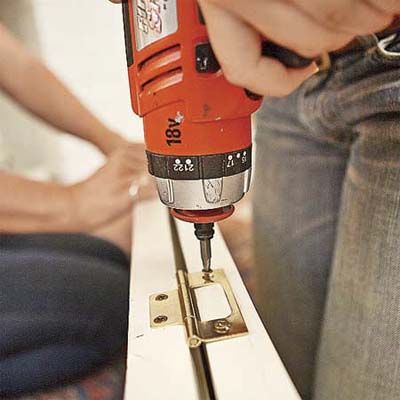
Choosing the Right Shutters
When choosing shutters for your cabinet doors, consider the size, material, and style that match your home’s interior. Look for shutters made of durable wood like mahogany or cedar, which can withstand construction and daily use. Salvage yards, flea markets, and online marketplaces are great options for finding vintage shutters. Choose shutters that are larger than your cabinets so you can trim them and make adjustments.
Cleaning and Repairing Old Shutters
When you’ve chosen your shutters, deeply clean them to remove dirt, dust, and any chipped paint. Inspect the shutters for damage and make any repairs. Fill in cracks or holes with wood filler and sand the surface smooth.
Removing Old Hardware
Remove any existing hardware from the shutters. This includes old hinges, latches, and decorative elements that won’t be part of your new cabinet doors. Use a screwdriver or drill to carefully remove these items and prevent damaging the wood.
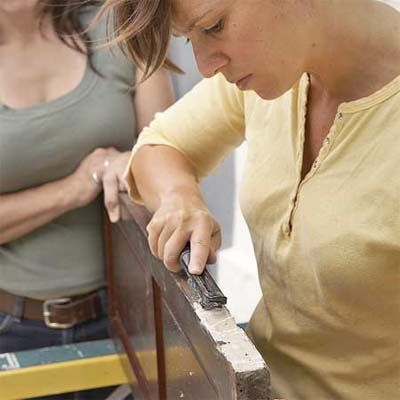
Filling and Sanding
Next, fix any imperfections in the shutters after removing the hardware. Fill old hinge mortises and any other screw holes with epoxy filler. After letting it dry completely, use a rasp to smooth the epoxy buildup. Sand the entire surface of the shutters to create a smooth base for painting. Start with a coarse-grit sandpaper and move to finer grits for a polished finish.
Converting Shutters Into Cabinet Doors
Now that your shutters are prepped, you can start constructing them into cabinet doors by measuring, cutting, creating hinges, and assembling your doors.
Measuring and Cutting
Measure your cabinet openings carefully and mark your shutters. If necessary, use a jigsaw to trim the shutters to the correct size. Remember to account for any overlap or reveal you want around the edges of the cabinet opening. If you’re creating a bifold door from two shutters, you may need to remove the rabbets (light-blocking strips where opposing pairs of shutters meet) to create smooth edges.
Creating Hinge Mortises
For proper door function, you’ll need to create new mortises for the hinges. Measure and mark the locations for your hinges, typically about three inches from the top and bottom of the shutter. Score around the hinge outline with a utility knife, then use a chisel to carefully remove the wood to the depth of the hinge plate. This step will help your cabinet doors operate and hang correctly.
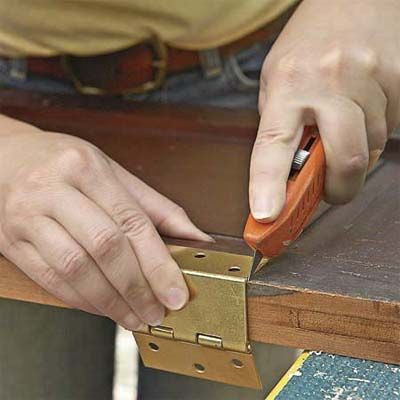
Assembling Your Cabinet Doors
Once the mortises are created, it’s time to assemble your cabinet doors. If you have multiple shutters to create a set of bifold doors, join the shutters together using door hinges. Align the shutters carefully so they can open and close easily. Check the alignment by placing the assembled doors against the cabinet frame.
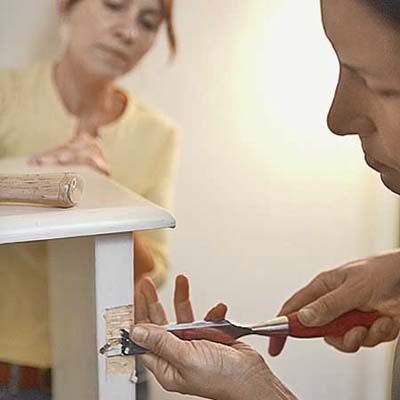
Painting and Finishing Your New Cabinet Doors
A fresh coat of paint can transform the look of your shutter cabinet doors and provide a layer of protection against general wear and tear.
Priming the Shutters
Start by applying a coat of primer to both sides of your shutters. This step helps the paint adhere better. Allow the primer to dry completely, then lightly sand the surface to remove any raised grain or imperfections.
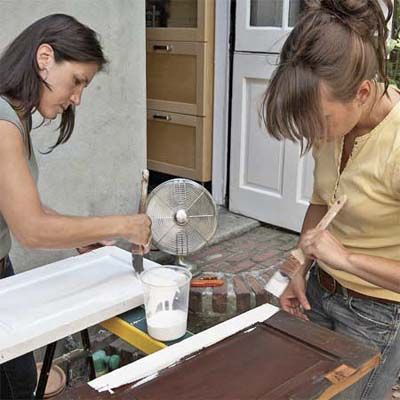
Applying the Final Coat
Apply two coats of latex paint, allowing each coat to dry and lightly sand between applications for a smooth finish. Use a high-quality paintbrush or consider spray painting for even coverage, especially if your shutters have intricate details.
Installing Your New Shutter Cabinet Doors
With your shutters painted and ready, it’s time to install them as your new cabinet doors.
Attaching the Hinges
Fit the hinges into the mortises you created earlier. Predrill holes for the screws to prevent splitting the wood, then fasten the hinges to the shutter. If you want a full 180-degree opening, which is customary for most cabinets, you’ll want to install wraparound hinges.
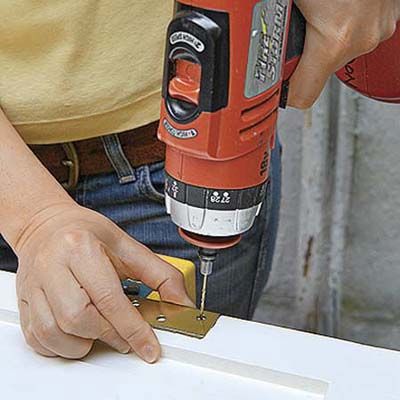
Mounting the Doors
Hold the shutter in place against the cabinet frame, getting some assistance as needed. Mark the position of the hinges on the frame, then create matching mortises in the cabinet. Carefully align the door and screw the hinges into place. Test the door’s operation and make any adjustments if the door isn’t closing fully or operating smoothly.
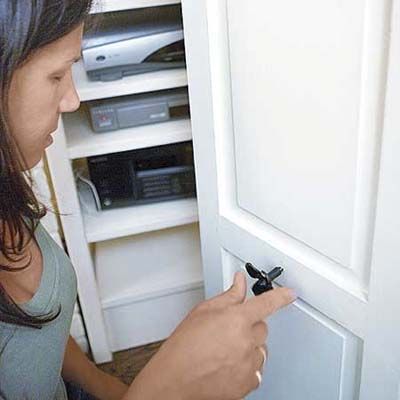
Creative Design Ideas for Shutter Cabinet Doors
With any DIY project, you have the chance to customize whatever you’re constructing. For shutter cabinet doors, depending on your home’s decor, you can design a distressed look or install glass inserts or mirrored panels.
Distressed Look
If you want a rustic or farmhouse look, you can give your cabinets a distressed finish. To do this, lightly sand edges and raised areas to show the wood or primer underneath. This adds depth and shading to your doors, making them look aged.
Glass Inserts
You can also replace some of the shutter slats with glass inserts for a different aesthetic. This allows you to display items inside the cabinet and still repurpose old shutters. Carefully remove the selected slats, install trim to hold the glass, and secure the panes in place.
Mirrored Panels
Installing mirrored panels into your shutter doors can make the space in your room feel larger and brighter. Replace some slats with mirrors cut to size, and secure them with mirror adhesive and trim.
Maintaining Your Upcycled Cabinet Doors
Dust your shutter cabinets frequently with a soft cloth and clean the doors with a mild soap solution when necessary to keep your handiwork in good condition. Avoid using harsh chemicals that could damage the paint finish. Check and tighten hinge screws as needed to keep the doors aligned correctly.
Troubleshooting Common Shutter Cabinet Issues
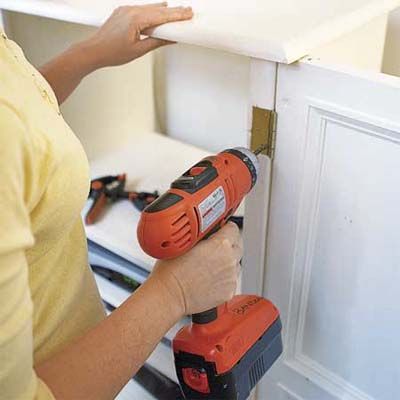
Even with careful planning and construction, you may encounter some challenges with your shutter cabinet doors. Alignment and paint adhesion are the most common issues, especially when repurposing older items.
Alignment Problems
If your doors don’t align properly or have gaps when you close them, you may need to adjust the hinges. Most hinges come with adjustment screws that let you fine-tune the door’s position. Make small adjustments until the door hangs evenly and closes flush with the cabinet frame.
Paint Adhesion Challenges
If you notice paint peeling or chipping, it’s likely due to improper surface preparation or incompatible paint types. To fix this, sand the affected areas, apply a bonding primer, and repaint the surface. You should always clean and sand thoroughly before painting, and remember to use paints formulated for the material of your shutters.
Our Conclusion
Transforming old shutters into cabinet doors is a rewarding DIY project that combines creativity, sustainability, and practicality. This approach to cabinet door design allows you to renovate your interior in a budget-friendly way. With basic tools and some carpentry skills, you can create custom cabinet doors at a fraction of the cost.

